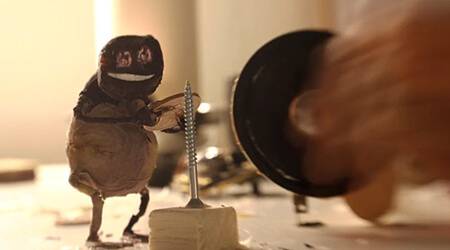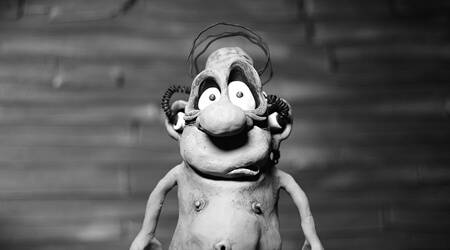BFP15 – Screenings (Part 1)
The 2015 Bristol Festival of Puppetry – which continues throughout this week with events including an assortment of free animation screenings – has been an eye-opening and tremendously positive few days celebrating puppet craftsmanship and performance within theatre, film and animation. This year’s edition has expanded its film programming significantly, with a far wider variety of screenings celebrating the different ways puppetry can be used in storytelling. With animation obviously having a large part to play, two main screenings were developed by curator Joseph Wallace focusing on different ends of the spectrum – Lightness “featuring films bursting with hope, colour and unexpected twists” and Darkness “delving deeper into the psyche of the puppet”.

Unity (Dir. Tobias Stretch. 2014)
Lightness
Rather than simply grouping an assortment of cheery, kid-friendly uplifting shorts to be later juxtaposed against a compilation of dark, unsettling, adult-only ones, the approach to the programming of each screening is a little more conceptual; although there’s something curiously affirming about Tobias Stretch’s Unity, (an abstract story of loneliness and transcendence created using a fascinating combination of pixilation, sculpture, stop-motion and frame-blending) its recurring visual motifs are death and decomposition. That isn’t to say there’s nothing cheery or comedic on offer – amongst the live-action highlights are Asking Out Tim (Dir. Peter Snell), a joyful little micro-skit about indefatigable optimism and persistence, the elaborate cardboard construction of Rebecca Manley’s Table Manners and the palpable tactility of Yves Geleyn mini-fairytale Colosse – A Wood Tale, whose main character blends seamlessly with his animated companion.
Onto the animation side of things, the McLaren Award-winning Stems by Ainslie Henderson (I Am Tom Moody, Monkey Love Experiments) is perhaps his most visually striking yet, taking a metaphysical angle reminiscent of frequent collaborator Will Anderson‘s work with a sublime use of sound, music and approach to puppet construction.

Stems (Dir. Ainslie Henderson, 2015)
But Milk is Important is a film we’ve returned to time and time again, each occasion offering a new area of the production to revel in. With this viewing one element that struck me in particular was, much like Stems, just how much attention had been paid to the interplay of sound and music. A fond reminder that stop-motion has its place in the world of broadcast commercials was a presumably rare big-screen outing for Joseph Mann and Andrew Thomas Huang’s Barry the Biscuit Boy, a milk campaign that makes this animator’s heart swell for terrifying the children of the nation (they’ll thank us later).
The well of Skwigly praise for Marc James Roels and Emma de Swaef’s masterpiece Oh Willy… has near run dry at this point, but it has to be said that, a few years down the line, it’s always a treat to be amongst people who are seeing it for the first time and it makes fine companion viewing alongside their more recent Natuurpunt promo The Garden Ape.
Darkness
This screening similarly takes a less straightforward approach to its thematic grouping, at least where the animation is concerned; generally speaking the live-action offerings could all be categorised as dark comedy, save for the more theatrical, performance-based Sanko by Phantom Limb Company. Viral smash Don’t Hug Me I’m Scared 2: Time will very probably never get old, with Action Man Battlefield Casualties marrying horrifically funny and – perceivably – glib satire with what is in fact a rather sincere campaign. Also worth a nod is Matt Harris-Freeth’s Crocodile, which rather effectively subverts the idea that puppets are merely innocuous founts of wisdom and puckish companionship; the audience isn’t quite let in on precisely what kind of universe the film takes place in until the final moments.
Back to the animation, two films whose puppet construction are especially appealing are Aron Bothman’s Feast In A Fallen City and Jamie Caliri’s Shins music video The Rifle’s Spiral. The densely packed action of the latter in particular serves as an extremely satisfying showcase of the skill and craftsmanship at play. Old favourites include Augusto Zanovello’s Lettres de Femmes and Mikey Please’s Marilyn Myller, whose much-loved story of creative ennui, frustration and how art is arbitrarily rewarded doubtless has resonance with the BFP crowd.

Ernie Biscuit (Dir. Adam Elliot, 2015)
The undeniable highlight is Ernie Biscuit, Adam Elliot‘s latest tale and first venture into a far more independent realm of film production. As with all his films, the story weaves tragedy and comedy, laced with a touch more overall positivity than those which preceded it. The circumstances of the production have brought elements from all of these into play – the limited animation style of his original trilogy Brother, Cousin and Uncle, the nomadic story that serves as a companion piece to Harvie Krumpet and the slicker presentation of recent feature Mary and Max. The film is tremendously satisfying to watch and improves with repeat viewings, so any opportunity to see it during its festival run should be embraced.
Certainly something that major festivals that feature animation as a strand rather than a focus have given audiences an opportunity to see how effectively animated films sit alongside its live-action fellows. The uniqueness of the Puppet Place mission statement, instead pairing up stop-motion with live-action puppetry, allows for an entirely different viewing experience and serves to celebrate just how essential each approach is to the stories being told.
Keep your eyes on Skwigly for more BFP15 coverage in the coming days. For more on the festival and the work of Puppet Place visit puppetplace.org

